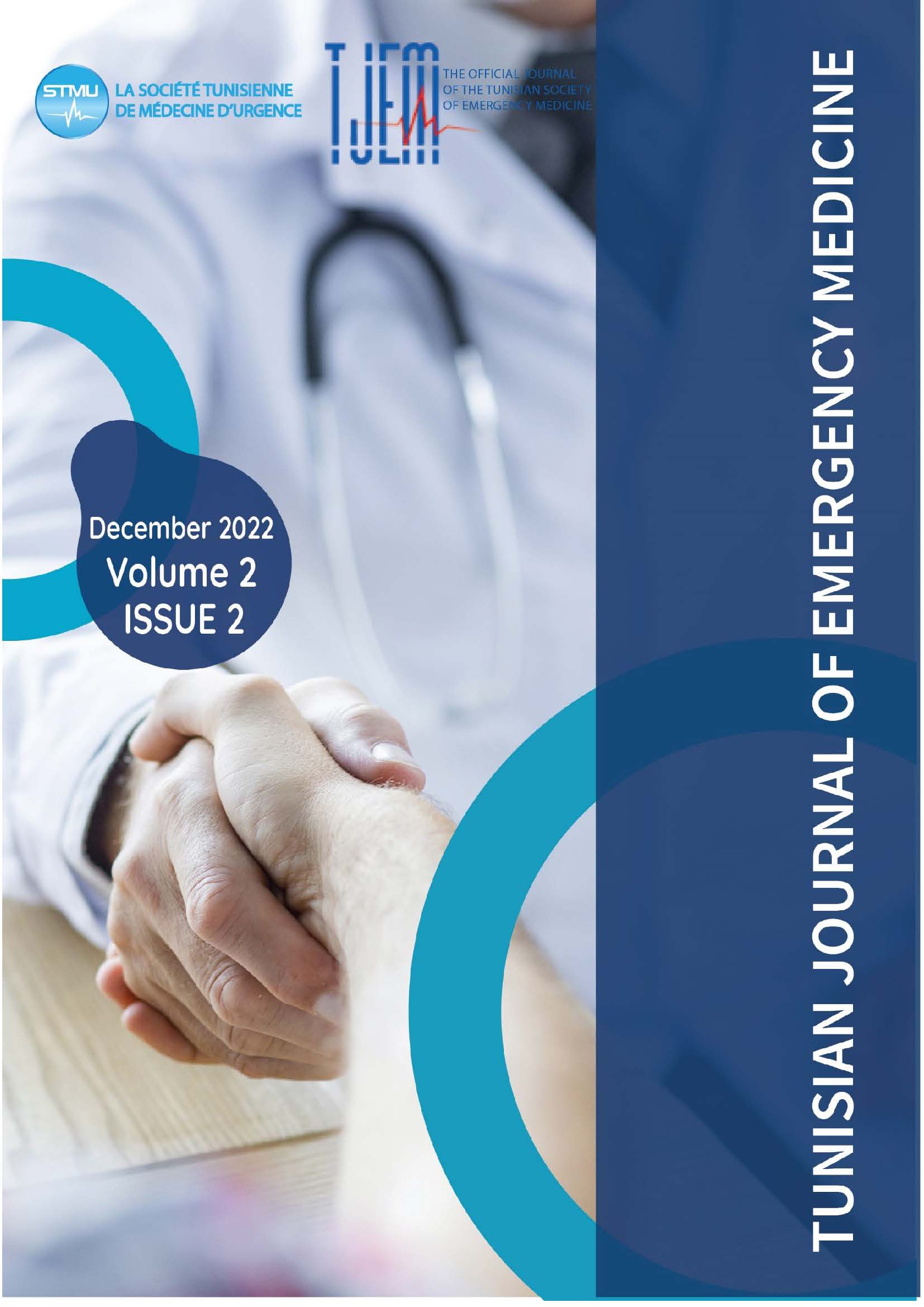Value of inferior vena cava diameter respiratory change as a marker of heart failure in COPD exacerbation
Cyrine KOURAICHI, Adel SEKMA, Hamdi BOUBAKER, Wahid BOUIDA, Semir NOUIRA
DOI:
https://doi.org/10.0000/yqhfw126Keywords:
COPD, Heart Failure, ultrasound, Inferior Vena Cava Diameter, OutcomesAbstract
Introduction: Chronic obstructive pulmonary disease (COPD) is a frequent disease affecting mainly the elderly and males. Dyspnea is the most common reason for consultation for patients with COPD in ER. Distinguishing between pulmonary and/or cardiac origin can be challenging, hence the interest in ultrasound and in particular the study of the collapsibility index of the inferior vena cava
Objective: To det exacerbation of COPD (AECOPD).
Methods: This is a prospective study conducted in the ED of three Tunisian university hospitals from January 2022 to Mars 2022 including patients with AECOPD. During this period, 401 patients met the inclusion criteria. The final diagnosis of HF is based on the opinion of two emergency experts after consulting the data from the clinical examination, cardiac echocardiography, and BNP level. was calculated by Two experienced emergency physicians clinical and laboratory data, using the formula: (IVC max-IVC min) / IVC min x 100. A cut-off of 15% was used to define the presence (<15%) or absence of HF The left ventricular ejection fraction (LVEF) is also measured (cut-off preserved/reduced).
Results: The study population is relatively elderly with an average age of 67.2 years, predominantly male (68.9%), and characterized by heavy comorbidity and cardiopulmonary risk factors. The patients were divided into two groups according to the final diagnosis of HF; 165 patients (41.1%) had a final diagnosis of HF (HF group) and 236 patients (58.9%) without HF (non-group). Patients in the HF group had more comorbidities with higher rates of hypertension (p=0.001), chronic HF (CHF), coronary artery disease, and diabetes sensitivity of 37.4% and a specificity of 89.7% using the threshold of 15%, which appears to be associated with the best diagnostic performance; the positive predictive value is 70.9% and the negative predictive value is 66.7%. The area under the ROC curve is 0.71(95%, CI 0.65 0.76). were not different between HF patients with reduced LVEF (LVrEF) and those with preserved LVEF (LVpEF)
Conclusion: Our main results show that the has a good value for ruling out HF in COPD patients consulting emergency rooms for acute dyspnea.
Downloads
Published
Issue
Section
License
Copyright (c) 2022 Tunisian Journal of Emergency Medicine

This work is licensed under a Creative Commons Attribution-NonCommercial-ShareAlike 4.0 International License.
How to Cite
Similar Articles
- safia othmani, Ischemic acute cholecystitis: a case report , Tunisian Journal of Emergency Medicine: Vol. 2 No. 4 (2024): TJEM Vol2 Issue4
- Amira Sghaier, Marwa Toumia, Khaoula Bel Haj Ali, Adel Sekma, Kaouthar Beltaief, Zied Mezgar, Wahid Bouida, Riadh Boukef, Jamel Saad, Hamdi Boubaker, Mohamed Amine Msolli, Mohamed Habib Grissa, Semir Nouira, B-lines Ultrasonography Assessment by Nurses for the Diagnosis of Heart Failure in the Emergency Department , Tunisian Journal of Emergency Medicine: Vol. 2 No. 4 (2024): TJEM Vol2 Issue4
- Sondes laajimi, haifa bradai, Nabil Chebbi, Dorra Loghmari , imen EL KISSI, Naoufel Chebili , rabeb Mbarek, Specific Features of Chest Pain in Young People treated in Prehospital Care , Tunisian Journal of Emergency Medicine: Vol. 3 No. 1 (2025): TJEM 2025: Vol.3 Issue 1
- Wiem Feki, Fatma Hammami, Amina Kammoun, Makram Koubaa, Zaineb Mnif, Vascular causes of pediatric acute ischemic stroke: the crucial role of imaging , Tunisian Journal of Emergency Medicine: Vol. 3 No. 2 (2025): TJEM 2025: Vol.3 Issue 2
- Rim Karray, Kais Ben Jeddou, Hana Ksentini, Leila Chaari, Adel Chaari, Noureddine Rekik, The Perthes syndrome: a case report , Tunisian Journal of Emergency Medicine: Vol. 3 No. 1 (2025): TJEM 2025: Vol.3 Issue 1
- mahmoud ladhar, Chourouk Frikha, Manel Feki, Mouna Loukil, Faiza Safi, Mortality in Pediatric Intensive Care , Tunisian Journal of Emergency Medicine: Vol. 3 No. 2 (2025): TJEM 2025: Vol.3 Issue 2
- Rania Hammami, Syrine Triki, Aimen Dammak, Faiza Safi, Olfa Chakroun , An abrupt cardiogenic shock in a female at the era of COVID 19 pandemic lockdown , Tunisian Journal of Emergency Medicine: Vol. 3 No. 1 (2025): TJEM 2025: Vol.3 Issue 1
- Rabeb Mbarek, Khouloud Hamdi, Sarra Soua, Hela Abroug, Sondes laajimi, haifa Bradai, Dorra Loghmari , Asma SRIHA, Semir Nouira, Prehospital Particularities of Covid-19 infection and factors associated with its severity during the omicron variant wave (East-center of Tunisia) , Tunisian Journal of Emergency Medicine: Vol. 2 No. 4 (2024): TJEM Vol2 Issue4
- Sarra Akkari , Emna Rachdi , Jalila Ben Khlil , Prognosis in COVID-19: Impact of Pre-hospital Emergency Care , Tunisian Journal of Emergency Medicine: Vol. 2 No. 4 (2024): TJEM Vol2 Issue4
- Lassaad CHTOUROU, Jejunal Diverticulosis: Review , Tunisian Journal of Emergency Medicine: Vol. 2 No. 4 (2024): TJEM Vol2 Issue4
You may also start an advanced similarity search for this article.

